Types of Hydrangea Bushes (with Pictures): Identification and Growing Guide
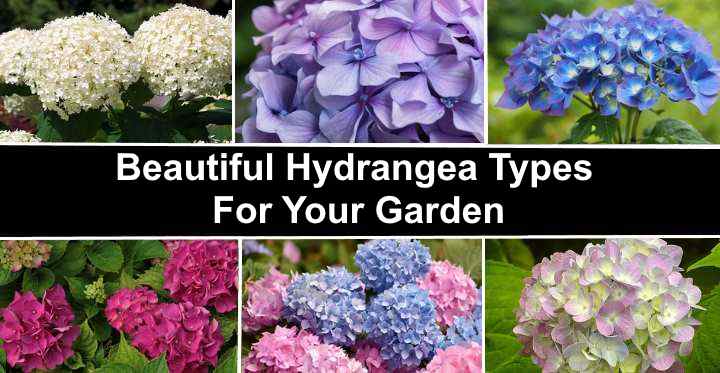
Hydrangeas are beautiful bushy deciduous shrubs with large, colorful, showy flowers and large bright to dark green leaves. Hydrangea flowers bloom in shades of blue, lavender, white, pink, red, green, and purple. The bigleaf hydrangea (Hydrangea macrophylla) is the most popular of these flowering bushes. Other types of hydrangea bushes include smooth hydrangeas, oakleaf hydrangeas, climbing hydrangeas, panicle hydrangeas, and mountain hydrangeas.
There are hydrangea varieties suitable for most garden landscapes. If you have a small, compact garden, then a dwarf hydrangea variety is ideal. You will even find a small, miniature hydrangea if you want a patio plant and grow hydrangea flowers in a container.
A characteristic of hydrangea flowers is that their color can depend on the type of soil. For example, a blue hydrangea may have showy lilac or light purple flowers in acidic soil, but in alkaline soil, the mophead flower will be pinkish. With proper care, your beautiful hydrangea bush can flower throughout the summer until the fall.
This article is a guide to the many different hydrangea varieties and cultivars suitable for your garden. Descriptions of these large leafy shrubs and pictures of hydrangea flowers will help choose the best hydrangea for your garden.
Hydrangea Varieties for Landscaping — Overview
Hydrangeas are easy to grow multi-stemmed perennial deciduous shrubs with colorful flowers and dense leafy foliage. Most hydrangea cultivars thrive in USDA zones 3 through 9. Depending on the cultivar, hydrangea bushes grow best in partial shade. However, some hydrangea flowers flourish in full sun.
The advantage of growing hydrangea shrubs in your garden is their versatility. Hydrangeas thrive in almost any type of soil, tolerate wind, and grow well in coastal regions.
How Big Do Hydrangea Get?
Most hydrangeas are large shrubs that grow between 3 and 5 ft. (1 – 1.5 m) high. The tallest types of hydrangeas are climbing hydrangeas (Hydrangea anomala) that reach up to 50 ft. (15 m) tall if they have enough support. Dwarf hydrangeas varieties are typically 2 or 3 feet (0.6 – 1 m) tall.
Hydrangeas usually have a similar spread to their height. This growth feature of hydrangeas makes it easy to plan to grow these stunning flowers in your garden.
Hydrangea Flowers
Hydrangea flowers are long-lasting, showy blooms that have various shapes and sizes. The stunning flower heads can be rounded domes, flat lacy clusters, pointed cone shapes, or huge ball-like flowers.
Here are the types of hydrangea flowers:
Mophead hydrangea flowers are large, showy blossoms with rounded, dome-shaped clusters. Also called pom-pom hydrangeas, these popular garden flowers can be as large as a dinner plate. Mophead hydrangea flowers can measure between 4” and 14” (10 – 35 cm) across. Mophead flowers grow on bigleaf (French) hydrangeas and bloom from late spring until midsummer. The flower color is blue in acidic soil and pink in alkaline soil.
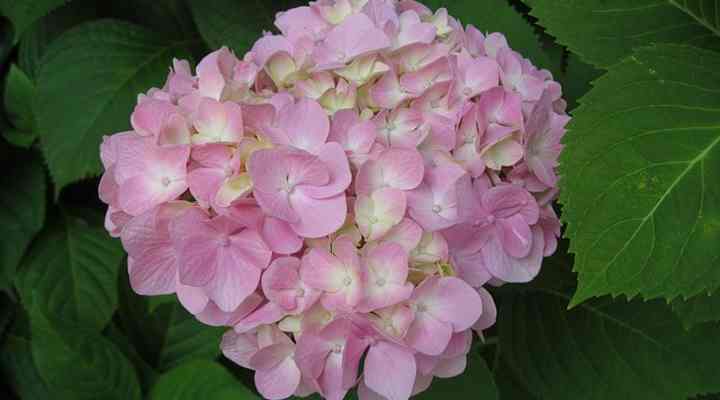
Mophead hydrangea flowers
Lacecap hydrangea flowers are unusual flowers growing in flat clusters on bigleaf hydrangeas. The flower heads bloom during summer until fall. The hydrangea flowers consist of small floret clusters in the center and a ring of 4- or 5-petaled flowers around the edge. The flower color is blue in acidic soil and pink in alkaline soil.
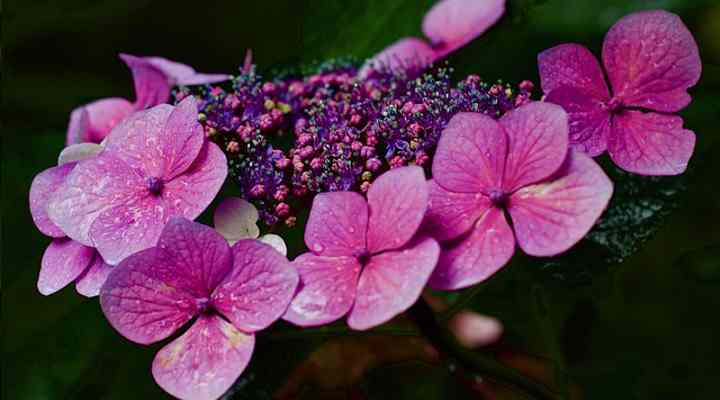
Lacecap hydrangea flowers
Panicle hydrangea flowers are cone-shaped flower heads that can be white, vibrant pink, pastel pinkish-red, or green. Panicle cone hydrangea flowers bloom from late spring until the frost.
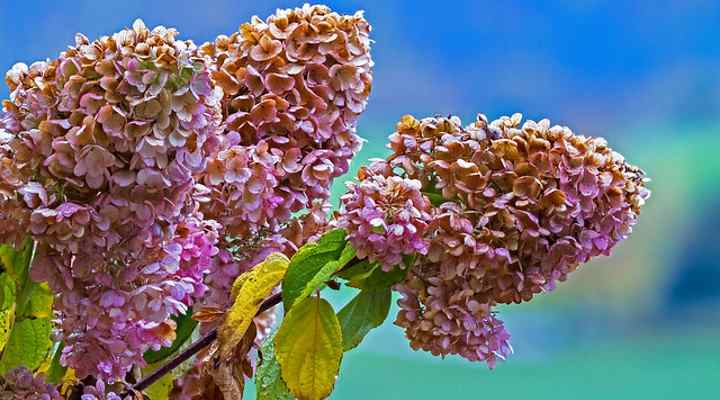
Panicle hydrangea flowers
Snowball hydrangea flowers are stunning globe-like white flowers that grow up to 12” (30 cm) in diameter.
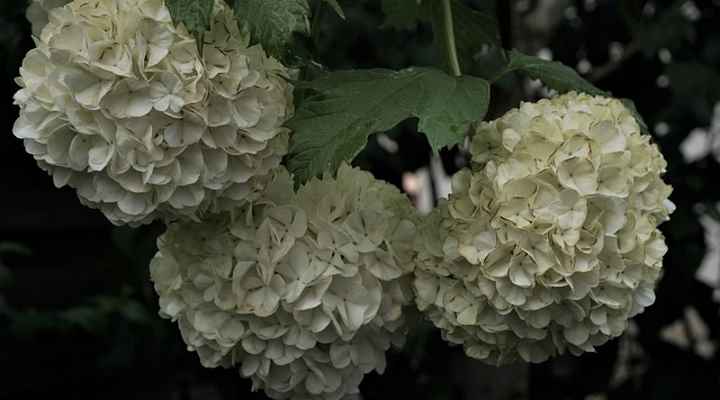
Snowball hydrangea flowers
Hydrangea Leaves
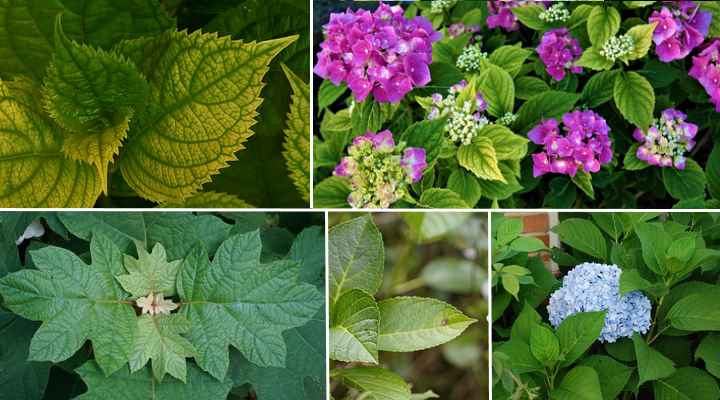
Hydrangea leaves come in different forms and sizes depending on the species
Hydrangea bushes are known for their large leathery pointed ovate leaves. The shape and form of hydrangea leaves depend on the hydrangea type and cultivar.
Here are the types of hydrangea leaves:
Bigleaf hydrangeas leaves are thick and glossy with serrated margins and grow up to 8” (20 cm) long.
Panicle hydrangeas have narrow, dark-green fuzzy leaves that grow up to 5” (12 cm) long.
Smooth hydrangea leaves have a coarse texture and medium to dark green color. Leaves on smooth hydrangea bushes grow up to 8” (20 cm) long.
Oakleaf hydrangea leaves. As the name suggests, these hydrangea leaves look like oak leaves. The dull grayish-green summer foliage turns a spectacular red or orange in the fall.
Climbing hydrangea leaves are aromatic leaves that are a rounded to ovate shape with toothed edges. From the different hydrangeas varieties, climbing hydrangea leaves are the smallest, measuring between 2” and 4” (5 – 10 cm) long.
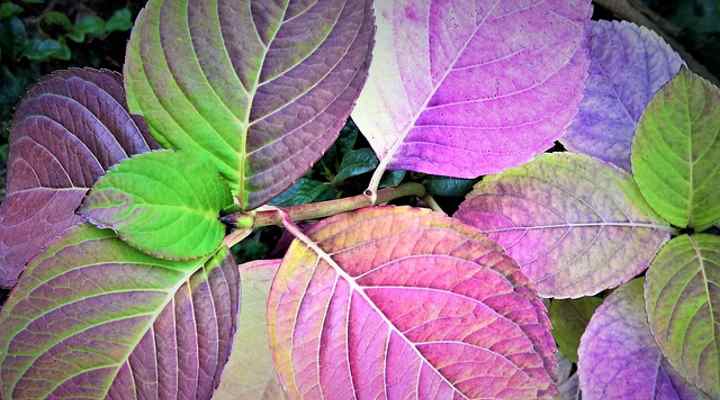
Hydrangea leaves in fall
Types of Hydrangea Bushes – Overview
Hydrangeas are classified into different species depending on the type of flower, leaves, and growth pattern.
Here are the six varieties of hydrangea bushes:
- Bigleaf Hydrangea (Hydrangea macrophylla)—Also called mophead hydrangea, French hydrangea, or pom-pom hydrangea. These hydrangeas have large colorful dome-shaped flowers or lacecap flowers. Flower color varies depending on the soil pH. These popular large-leaved hydrangeas grow 4 ft. (1.2 m) tall and wide.
- Oakleaf hydrangea (Hydrangea quercifolia)—Cylindrical flower clusters that grow 6” to 12” (15 – 30 cm) tall. Colors are typically white or pink and are not affected by pH levels in the soil. Oakleaf hydrangeas grow between 3 and 12 ft. (1 – 3.6 m) tall.
- Panicle hydrangea (Hydrangea paniculata)—Cone-shaped hydrangea flower clusters that are typically white and light green. These hydrangea shrubs grow between 3 and 16 ft. (1 – 5 m) tall and 8 ft. (2.5 m) wide.
- Smooth hydrangea (Hydrangea arborescens)—These hydrangea shrubs usually have huge ball-like flowers that bloom from May until July. The hydrangea bush grows 10 ft. (3 m) tall and 6 ft. (1.8 m) wide.
- Climbing hydrangea (Hydrangea petiolaris)—Flowers on climbing hydrangeas look like flat-topped corymbs measuring between 6” to 10” (15 – 25 cm) wide. These plants are the tallest hydrangea varieties. The shrub grows up to 50 ft. (15 m) tall and 6 ft. (1.8 m) wide.
- Mountain hydrangea (Hydrangea serrata)—Mountain hydrangeas are identified by their lacy pink flower heads that grow on old wood. Like bigleaf hydrangeas, soil pH affects the flower colors. The shrub grows 4 ft. (1.2 m) tall and wide.
Planting Hydrangeas
Growing hydrangea shrubs that flower throughout the summer depends on growing them in the right place and the correct soil type. Here is a short guide to planting hydrangea bushes in a garden landscape.
When to plant hydrangeas: Plant hydrangea bushes after the last spring frost, or in fall before the first frost to give the flowering plants a chance to develop roots before the soil becomes really cold.
Where to plant hydrangeas: The best location to plant hydrangeas is where they get partial sun. Ideally, sun in the morning and shade in the afternoon. Plant the hydrangea in fertile soil that stays moist but drains well.
How to plant hydrangeas: Dig a hole that is two or three times the size of the root ball. Plant the hydrangea so that it’s higher than it was in the nursery pot. Fill the hole with organically rich soil, press down, and water thoroughly.
How to plant hydrangeas in pots: Plant hydrangeas in a suitable container filled with a loose potting mix that has excellent drainage.
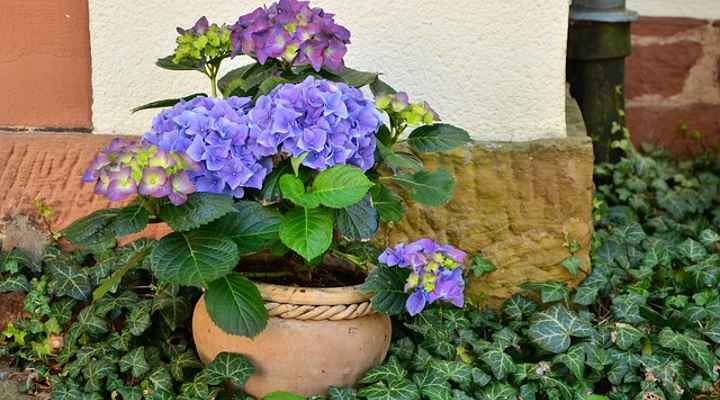
Potted hydrangea
Transplanting hydrangeas: You can transplant hydrangeas in the fall before the ground freezes. Dig a large hole in the new location where there is afternoon shade. Dig around the hydrangea bush to free the root ball. With the help of someone else, pry the large shrub from the ground. Replant in its new location.
How to Care for Hydrangea Shrubs
Grow hydrangea bushes in fertile soil that is amended with plenty of organic matter. Water hydrangeas enough so that the ground is moist but never too soggy. Use a slow-release fertilizer with an NPK rating of 10-10-10. Deadhead hydrangea flowers after blooming and prune dead stems to keep the plant tidy.
Types of Hydrangea (with Pictures)
Let’s look in more detail at stunning examples of hydrangea shrubs.
Bigleaf Hydrangea or Mophead Hydrangea (Hydrangea macrophylla)

Bigleaf Hydrangea / Mophead Hydrangea (Hydrangea macrophylla)
Bigleaf hydrangeas are the most popular flowering shrub in gardens. The common hydrangea names—bigleaf and mophead—refer to the leaf size and flower shape. The showy hydrangea flowers are large, rounded flower clusters. The large, bold glossy, ovate leaves can be 4” to 6” (10 – 15 cm) across.
Bigleaf hydrangea cultivars have two types of flowers: mophead flowers and lacecap flowers. The sizeable spherical mophead flowers bloom for three to six months and can turn color in the fall. Lacecap hydrangea flowers are flattened flower clusters. The flower heads consist of fertile florets in the center with showy petal flowers around them.
A characteristic feature of bigleaf hydrangeas is that the flowers can change color. In alkaline soils, bigleaf hydrangea produce pinkish flowers. In acidic soils they produce blue or lilac flowers.
Bigleaf hydrangea shrubs are ideal for foundation plantings, a deciduous flowering hedge, or specimen shrub.
Hydrangea leaves: Bigleaf hydrangea leaves are simple leaves, broadly ovate with serrated edges measuring 4” to 6” (10 – 15 cm) across. The leaves are arranged oppositely on stems
Hydrangea flowers: Rounded globular flower clusters or flattened flower heads, depending on the type of hydrangea. Mophead hydrangea flowers typically grow 6” to 8” (16 – 20 cm) across. However, some large-flower hydrangeas have enormous flowerheads 10” to 14” (22 – 35 cm) across. Flower color is blue in acidic soil and pink in alkaline soil.
Zone: 5 to 9
Sun exposure: Full sun in cooler climates and partial shade in warm regions.
Height and spread: 3 to 4 ft. (1 – 1.2 m) tall with a similar spread.
Nikko Blue Hydrangea (Hydrangea macrophylla ‘Nikko Blue’)
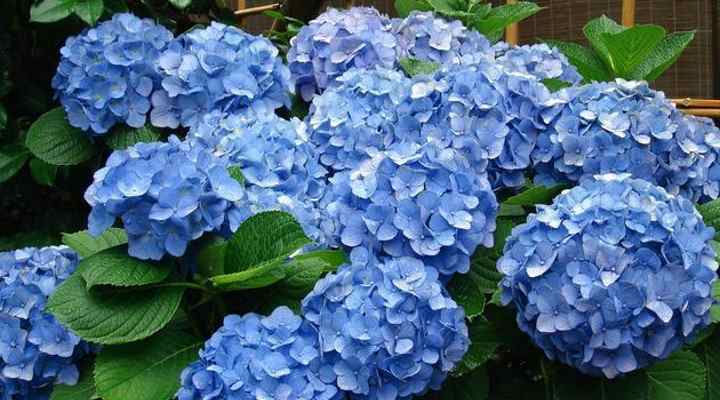
Hydrangea macrophylla ‘Nikko Blue’ with its flowers
The Nikko Blue hydrangea is one of the most popular mophead hydrangea shrubs. The flowering bush has deep blue florets contrasting with large green, ovate leaves. The ‘Nikko Blue’ blooms profusely from early summer until the fall. Flowers are blue in acidic soils and develop pink hues in alkaline soils.
Hydrangea leaves: ‘Nikko Blue’ lustrous medium green leaves are an obovate to elliptic shape measuring 4” to 8” (10 – 20 cm) long. The pointed leaves have serrated margins—typical of all hydrangea leaves.
Hydrangea flowers: ‘Nikko Blue’ flowers are spherical clusters of spectacular blue or pink florets. The large panicles bloom in June for two months. The hydrangea flowers measure 4” to 5” (10 – 12 cm) across.
Zone: 6 to 9
Sun exposure: Partial shade.
Height and spread: 4 to 6 ft. (1.2 – 1.8 m) tall and wide.
Endless Summer Bloomstruck Hydrangea (Hydrangea macrophylla ‘Endless Summer Bloomstruck’)
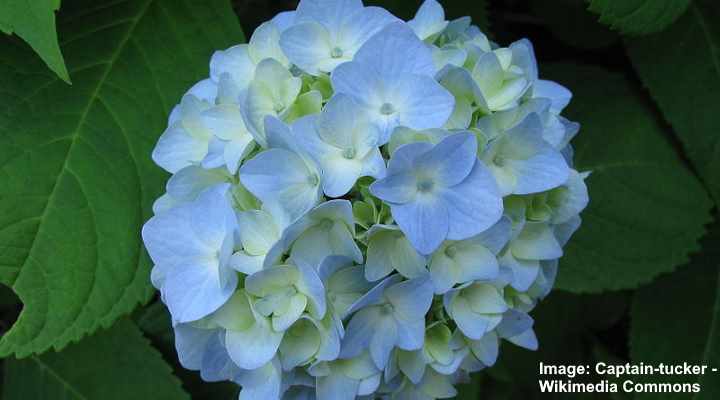
Hydrangea macrophylla ‘Endless Summer Bloomstruck’ with its flowers
The bigleaf hydrangea plant ‘Endless Summer Bloomstruck’ is a hardy mophead variety with two-toned lilac or pink flowers. A feature of the ‘Bloomstruck’ cultivar is large flowerheads growing on red stems. The Endless Summer cultivar has an attractive rounded growth habit.
Hydrangea leaves: Hydrangea ‘Bloomstruck’ dark-green serrated leaves are 4” to 8” (10 – 20 cm) long growing on the end of red petioles. The lush green hydrangea foliage turns reddish-purple in the fall.
Hydrangea flowers: ‘Endless Summer Bloomstruck’ flowers are deep rose or violet-blue depending on the soil pH. Flowers bloom on the hydrangea shrub all summer long. The globular flower heads are 5” (12 cm) across.
Zone: 4 to 9
Sun exposure: Part shade.
Height and spread: 3 to 4 ft. (1 – 1.2 m) tall and up to 5 ft. (1.5 m) wide.
Blushing Bride Hydrangea (Hydrangea macrophylla ‘Blushing Bride’)
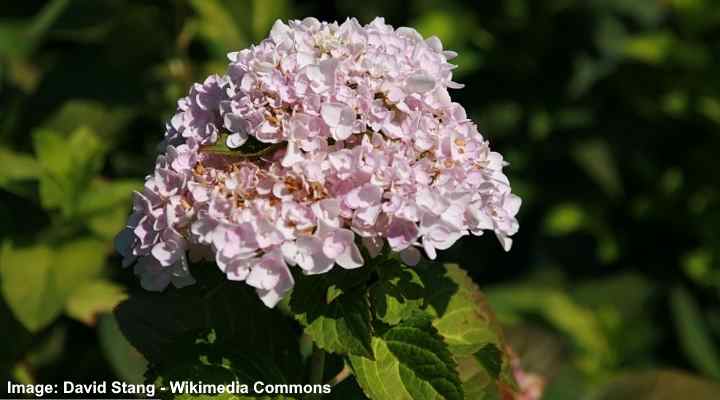
Hydrangea macrophylla ‘Blushing Bride’ flower
The ‘Blushing Bride’ is an Endless Summer hydrangea cultivar with brilliant-white spring blooms and dark-green leathery leaves. The ‘blush’ from the hydrangeas name refers to the tinges of purplish-blue or pinkish-purple on the white florets. The bigleaf hydrangea perennial shrubs have a mounding growth habit and thrive in most soils and locations.
Grow the ‘Blushing Bride’ hydrangea shrub as an informal hedge, foundation planting, container plant, or specimen bush.
Hydrangea leaves: The bigleaf hydrangea ‘Blushing Bride’ leaves are broadly ovate with toothed margins. The leaves measure 4” to 8” (10 – 20 cm) long from rounded base to tip.
Hydrangea flowers: ‘Blushing Bride’ hydrangeas have spectacularly packed white floret clusters with a bluish or pinkish tinge. The showy blooms measure up to 9” (22 cm) across.
Zone: 5 to 9
Sun exposure: Partial shade.
Height and spread: 3 to 6 ft. (1 – 1.8 m) tall and up to 4 ft. (1.2 m) wide.
Lacecap Hydrangea (Hydrangea macrophylla normalis)
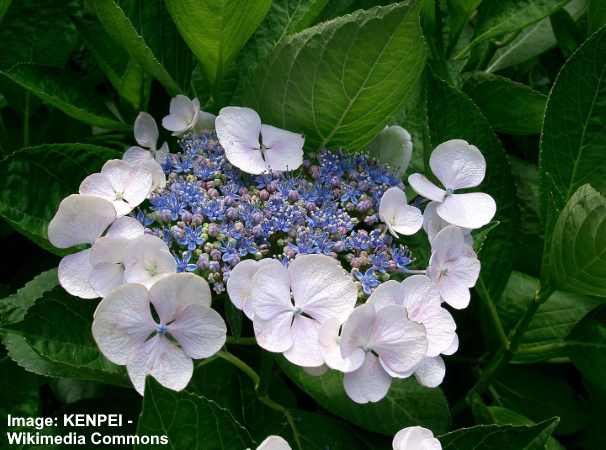
Hydrangea macrophylla normalis with its flowers
Lacecap hydrangea shrubs are beautiful flowering shrubs in the Hydrangea macrophylla species. The difference between lacecap hydrangeas and mophead hydrangeas is the shape of the flowers. Lacecap flowering shrubs have flower clusters that are flattened panicles. A cluster of small ball-like florets makes up the center surrounded by 4- or 5-petalled flowers.
The growing requirements for decorative bigleaf lacecap hydrangeas are the same as for mopheads. Generally, the shrubs perform best in partial sun in fertile, moist soil. Depending on the soil pH levels, the frilly hydrangea lacecap flowers can be blue or pink.
Hydrangea leaves: Lacecap hydrangea leaves are lush, green ovate blades with serrated, wavy edges. As a type of bigleaf hydrangea, lacecap varieties leaves measure 4” to 8” (10 – 20 cm) long.
Hydrangea flowers: Large, showy lacecap hydrangea blossoms consist of colorful buds in the center surrounded by showy flowers. Flower color is blue in acidic soil and pink in alkaline soil.
Zone: 4 (with some protection) to 9
Sun exposure: Full sun to partial shade.
Height and spread: 3 to 5 ft. (1 – 1.5 m) tall and wide.
Tree Hydrangea (Hydrangea paniculata)
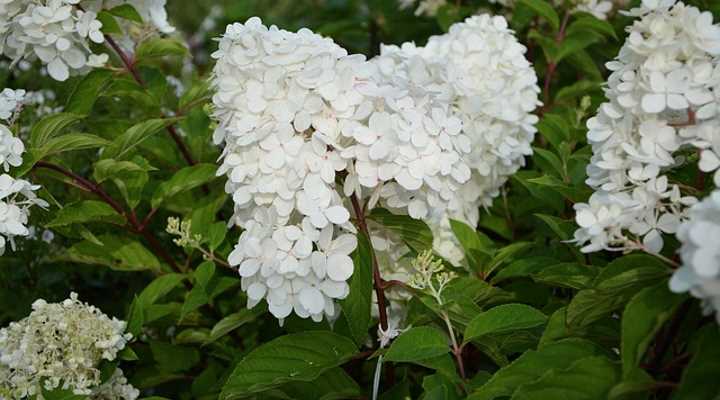
Tree Hydrangea or Panicle hydrangea (Hydrangea paniculata) with its flowers
The tree hydrangea (Panicle hydrangea) is a multi-stemmed landscape shrub that can be trained to grow as a single-stemmed hydrangea tree. This winter-hardy, easy-care hydrangea has cone-shaped panicles that bloom throughout summer until winter. The spectacular hydrangea flowers change from white to light pink as the season progresses.
The botanical name for this hydrangea species—paniculata—refers to the conical flower clusters. The Hydrangea paniculata can have an upright vase shape or arching, cascading branches depending on the cultivar.
If you live in a cold climate, tree hydrangeas are the ideal choice. The hardy, woody Panicle hydrangea shrubs can withstand severe cold and harsh winters. They are also more tolerant of drought than bigleaf hydrangeas.
Grow panicle hydrangeas as an ornamental specimen tree by removing suckers growing around the main stem. Alternatively, you can plant this hydrangea as a mixed border shrub, foundation planting, or flowering hedge. The beautiful cone hydrangea flowers are also ideal as cut flowers.
Hydrangea leaves: Tree hydrangeas have green leaves in an ovate or elliptical shape with serrated margins measuring 3” to 6” (7.5 – 15 cm) long and 3” (7.5 cm) wide. The rough leaves turn an insignificant yellow in the fall.
Hydrangea flowers: Panicle hydrangeas have white pyramidal flower clusters measuring 6” to 8” (15 – 20 cm) long that turn pinkish-rose in the fall.
Zone: 3 to 9
Sun exposure: Full sun to partial shade.
Height and spread: 8 to 15 ft. (2.4 – 4.5 m) tall and 6 to 12 ft. (1.8 – 3.6 m) wide.
Pee Gee Hydrangea (Hydrangea paniculata ‘Grandiflora’)
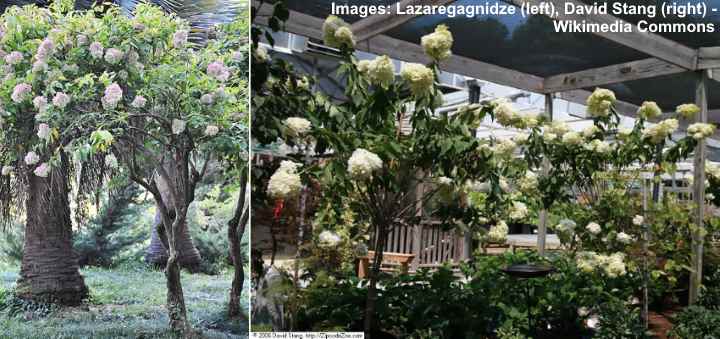
Pee Gee Hydrangea (Hydrangea paniculata ‘Grandiflora’)
The best tree hydrangea cultivar is the ‘Pee Gee’ variety. This multi-stemmed deciduous shrub is easy to train to resemble a beautiful specimen tree. As a flowering tree, the ‘Pee Gee’ hydrangea has a rounded, umbrella-like canopy covered in blooms throughout summer until the fall.
‘Pee Gee’ hydrangea has arching branches due to the weight of the huge flowers. The breathtaking beauty of this hydrangea cultivar makes it one of the most popular to grow in garden landscapes.
Hydrangea leaves: The leaves of ‘Pee Gee’ hydrangeas are dark-green, serrated ovate blades with a fuzzy feel. Leaves measure 3” to 6” (7.5 – 15 cm) long and 3” (7.5 cm) wide. Growing oppositely on woody stems, the large leaves create dense foliage.
Hydrangea flowers: ‘Pee Gee’ cone-shaped hydrangea flowers measure 12” to 18” (30 – 45 cm) long and up to 12” (30 cm) wide. The white florets develop pink tinges during the season. Blooming time is from midsummer until fall.
Zone: 3 to 8
Sun exposure: Full sun to partial shade.
Height and spread: 10 to 20 ft. (3 – 6 m) tall and up to 15 ft. (4.5 m) wide.
Limelight Hydrangea (Hydrangea paniculata ‘Limelight’)
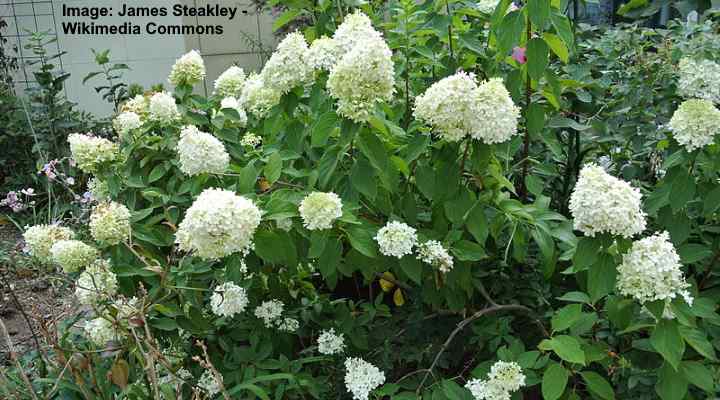
Hydrangea paniculata ‘Limelight’
The hydrangea cultivar ‘Limelight’ is a spectacular flowering deciduous shrub with huge, showy cone-like flowers that point upward. Like other species of Hydrangea paniculata, the ‘Limelight’ flowers change color during the season—from lime-green to creamy-white then rose pink.
The low-maintenance ‘Limelight’ hydrangea is perfect as an accent plant, flowering privacy screen, shrub border, or front-of-house plantings.
Hydrangea leaves: Pointed, dark-green oval leaves that turn stunning red shades in the fall.
Hydrangea flowers: Luscious conical flower clusters measuring between 6 and 12” (15 – 30 cm). The attractive white summer flowers turn pink-rose and then stay beige during winter.
Zone: 3 to 9
Sun exposure: Partial sun to full sun.
Height and spread: 6 to 8 ft. (1.2 – 1.8 m) tall and wide.
Little Lime Panicle Hydrangea (Hydrangea paniculata ‘Little Lime’)
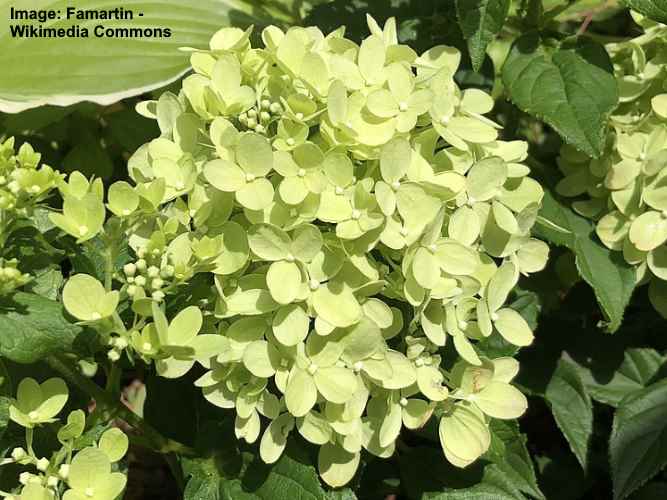
Hydrangea paniculata ‘Little Lime’
The hydrangea ‘Little Lime’ is a compact, dwarf hydrangea shrub from the ‘Limelight’ cultivar. The attractive features of the ornamental ‘Little Lime’ hydrangea shrub are lime-green flowers, large pointed green leaves, and a round, mounding growth. Also called the dwarf ‘Limelight’ hydrangea, this excellent shrub is ideal for growing in containers.
Ideas for growing the ‘Little Lime’ hydrangea include mass plantings along borders, foundation plantings, container gardens, or in front of walls or fences.
Hydrangea leaves: The ‘Little Lime’ hydrangea has leaves up to 2.5” (6 cm) long.
Hydrangea flowers: Lime green pyramidal flower clusters gradually turn pink throughout the season.
Zone: 3 to 8
Sun exposure: Full or partial sun.
Height and spread: 3 to 5 ft. (1 – 1.5 m) tall and wide.
Pink Hydrangea ‘Pinky Winky’ (Hydrangea paniculata ‘Pinky Winky’)
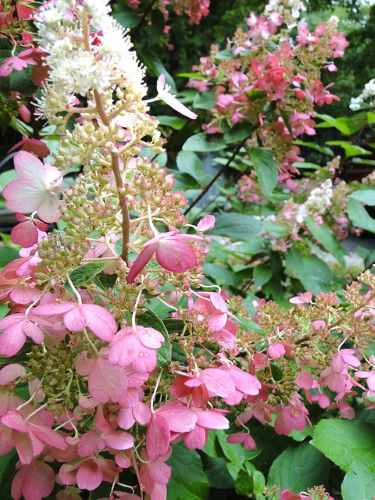
Hydrangea paniculata ‘Pinky Winky’
The ‘Pinky Winky’ is a compact flowering hydrangea shrub with massive, showy flower cluster cones in pink and white colors. The outstanding growth feature is how the enormous pointed white and pink panicles stand upright on stiff stems. In full bloom, masses of hydrangea flowers cover the shrub’s dense, dark-green foliage.
The ‘Pinky Winky’ hydrangea cultivar is an easy-care ornamental shrub. Grow the landscaping plant as a foundation planting, shrub border, flowering screen, or accent shrub.
Hydrangea leaves: Pointed, oval yellowish-green leaves 6” (15 cm) long with tooth-like edges. Like other Hydrangea paniculata cultivars, the ‘Pinky Winky’ doesn’t have impressive fall colors.
Hydrangea flowers: Bold, majestic hydrangea cone flowers that are 12” (30 cm) tall. New florets emerge white and turn deep pink. This feature gives the pink hydrangea a two-toned appearance.
Zone: 3 to 8
Sun exposure: Full sun to partial shade.
Height and spread: 6 to 8 ft. (1.2 – 1.8 m) tall and 6 ft. (1.2 m) wide.
Oakleaf Hydrangea (Hydrangea quercifolia)
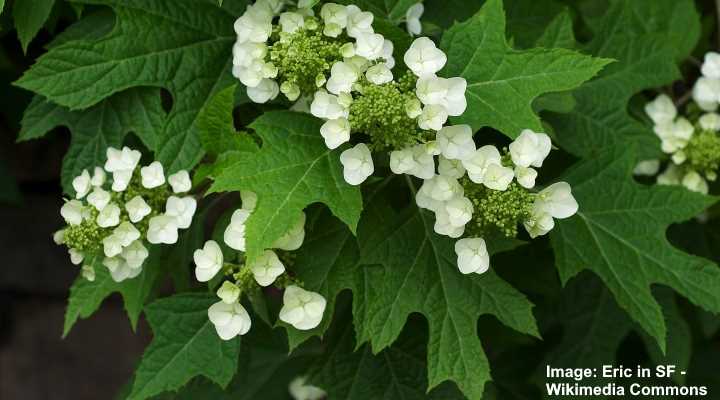
Oakleaf Hydrangea (Hydrangea quercifolia)
Oakleaf hydrangea is an ornamental, slow-growing, multi-stemmed shrub with conical clusters of white flowers. As a mounding shrub, the oakleaf hydrangea has a rounded habit with irregular branches. The glossy, lobed, leathery leaves have an overall ovate or obovate shape with serrated margins.
As the name suggests, the oakleaf hydrangea has unique leaves. The deeply lobed, broad green leaves look like large oak leaves. In the fall, the lush hydrangea leaves turn attractive hues of orange, purple, lavender, or red.
Grow oakleaf hydrangea plants as foundation plantings, an informal summer hedge, or mass along shrub borders.
Hydrangea leaves: Oakleaf hydrangea leaves are fleshy oak-like leaves with three to seven lobes. Leaves emerge fuzzy and gradually become smoother. Oakleaf hydrangea leaves measure 3” to 8” (7.5 – 20 cm) long and 2” to 6” (5 – 15 cm) wide.
Hydrangea flowers: Oakleaf hydrangea flowers are spectacular cone-like clusters. Emerging in spring, the perennial shrub flowers blooms last throughout the summer. Flowers appear white, turn to pink, then change to tan.
Zone: 5 to 9
Sun exposure: Partial shade.
Height and spread: 4 to 8 ft. (1.2 – 2.4 m) up to 10 ft. (3 m) wide.
Climbing Hydrangea (Hydrangea anomala)
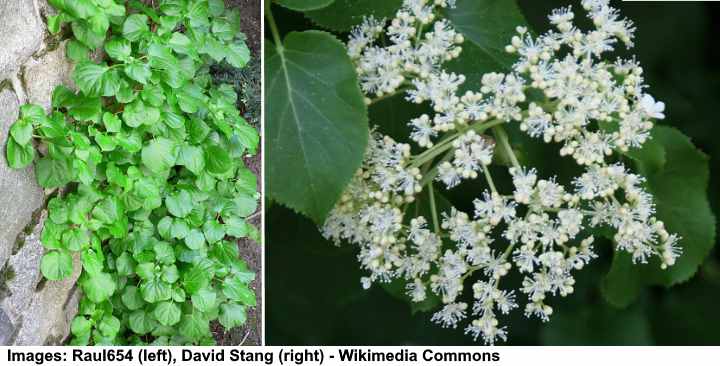
Hydrangea anomala subsp. petiolaris (climbing hydrangea)
Climbing hydrangeas are the tallest of the hydrangea species and a shade-loving plant. Although the massive flowering hydrangea vines can reach up to 80 ft. (24 m), you can prune the shrub to control its height. Hydrangea anomala subsp. petiolaris has white flower clusters of tiny buds and showy flowers.
To grow climbing hydrangeas as a garden vine, you will need a support such as a sturdy arbor, substantial pergola, or robust lattice fence. Due to the climbing hydrangeas plant’s twining vines and aerial roots, it will quickly grow up walls and attach itself to structures.
To grow climbing hydrangeas as a garden shrub, you will need to regularly prune the rapidly spreading vines. The mounding shrub with arching branches grows to between 3 and 4 ft. (1 – 1.2 m). You can also leave the creeping vines to create lush flowering, fast-growing ground cover for full sun.
Hydrangea leaves: The leaves of Climbing Hydrangea (Hydrangea anomala) are dark green, glossy, and heart-shaped, with a somewhat rounded to ovate form. They measure between 3 to 6 inches (7.5 to 15 cm) in length. In autumn, the foliage turns a yellowish color before falling off.
Hydrangea flowers: Climbing hydrangea flowers look like lacecap flowers. The flat-topped white flower clusters have showy flowers surrounding infertile flower buds, giving the flowers a lace-like appearance. The climbing hydrangea flat clusters measure between 6” and 10” (15 – 25 cm) across.
Zone: 5 to 7
Sun exposure: Full sun or partial shade.
Height and spread: 30 to 50 ft. (10 – 15 m) and 6 ft. (1.8 m) wide.
Smooth Hydrangea (Hydrangea arborescens)
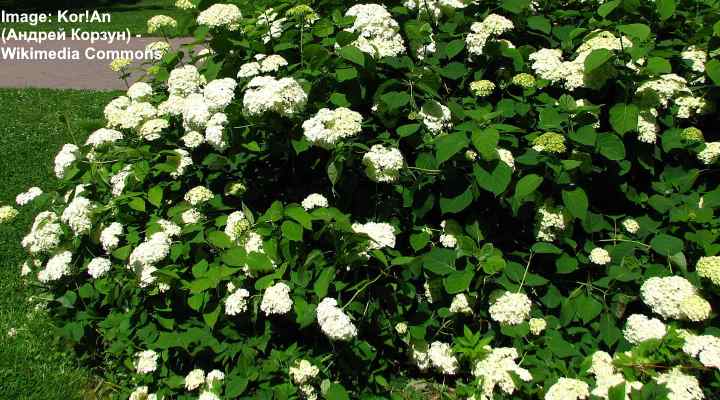
Smooth Hydrangea (Hydrangea arborescens)
The smooth hydrangea shrub has dark green oval leaves and clusters of tiny yellowish-green flowers and a few showy petals around the edges. Some smooth hydrangea cultivars have showy, spherical white flowers. A characteristic of the smooth hydrangea is its widely branching growth.
The smooth hydrangea is a cold-hardy hydrangea shrub that thrives best in moist soil and doesn’t tolerate drought. As a hardy perennial, it dies back in the winter in colder climates.
The botanical name of the smooth hydrangea—arborescens—means “tree.” This refers to the hydrangeas tree-like appearance of the larger shrubs.
Smooth hydrangeas are ideal shrubs for mass plantings as a shrub border or as a perennial privacy screen. If you want to choose a showy hydrangea for your garden, pick one of the Hydrangea arborescens cultivars.
Hydrangea leaves: Smooth hydrangea leaves are egg-shaped and measure 2” to 6” (5 – 15 cm) long. The pointed, green oval leaves have serrated margins and a pale green underside. In the fall, the dense foliage turns yellow.
Hydrangea flowers: Smooth hydrangea flowers are clusters of tiny bud-like yellowish-green flowers, like lacecap hydrangeas, but not as showy. Some cultivars have ball-shaped blooms. The flattened flower clusters measure 2” – 6” (5 – 15 cm) across and bloom from May until late July.
Zone: 3 to 9
Sun exposure: Partial shade.
Height and spread: 3 to 5 ft. (1 – 1.5 m) tall and wide.
Annabelle Hydrangea (Hydrangea arborescens ‘Annabelle’)

Hydrangea arborescens ‘Annabelle’
The smooth hydrangea cultivar ‘Annabelle’ has spectacular showy white flowers measuring 12” (30 cm) across. The plant’s showy flower heads sit on the ends of stiff stems, preventing them from drooping. ‘Annabelle’ hydrangea has a compact, rounded habit, making it ideal for foundation planting, as background for mixed beds, or in a woodland garden.
Hydrangea leaves: ‘Annabelle’ hydrangea leaves are dark green, measuring 3” to 8” (7.5 – 20 cm) long, and have serrated edges.
Hydrangea flowers: ‘Annabelle’ hydrangea flowers are showier than the species shrub. White dome-like blooms grow up to 12” (30 cm) across and bloom from June until August.
Zone: 3 to 9
Sun exposure: Partial shade.
Height and spread: 3 to 5 ft. (1 – 1.5 m) tall and 4 to 6 ft. (1.2 – 1.8 m) wide.
White Hydrangea ‘Incrediball’ (Hydrangea arborescens ‘Incrediball’)
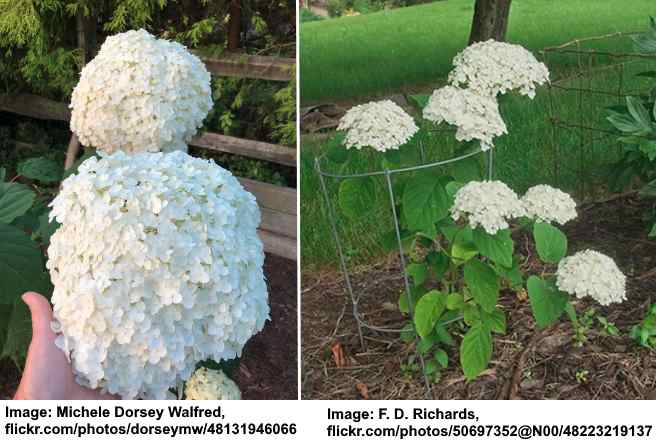
Hydrangea arborescens ‘Incrediball’
The ‘Incrediball’ hydrangea cultivar is a spectacular deciduous flowering shrub with huge greenish-white or pure white flowers and dark green egg-shaped leaves. This smooth hydrangea cultivar blooms all summer long. Its giant flower heads are showier than the related ‘Annabelle’ cultivar.
Hydrangea leaves: ‘Incrediball’ hydrangea leaves are broadly ovate to rounded with toothed edges. Leaves are dark green on the upper side and pale green underneath. The leaves measure 2” to 6” (5 – 15 cm) from stem to pointed tip.
Hydrangea flowers: ‘Incrediball’ hydrangea flowers are densely packed with tiny florets standing upright on stiff stems. The ‘Incrediball’ petals emerge as lime-green and change to brilliant white. This hydrangea blooms in June for two months.
Zone: 4 to 9
Sun exposure: Partial sun.
Height and spread: 3 to 5 ft. (1 – 1.5 m) tall and 4 to 6 ft. (1.2 – 1.8 m) wide.
Types of Dwarf Hydrangea (With Pictures)
Dwarf hydrangeas are ideal landscape plants for small, compact gardens. Most miniature or small hydrangea shrubs are suitable for containers and add color to patios, deck areas, entranceways, or container gardens. Generally, dwarf hydrangeas don’t grow taller than 4 feet (1.2 meters).
Here are some of the most outstanding dwarf hydrangea plants you can grow in your garden or backyard landscape.
Mountain Hydrangea (Hydrangea serrata)
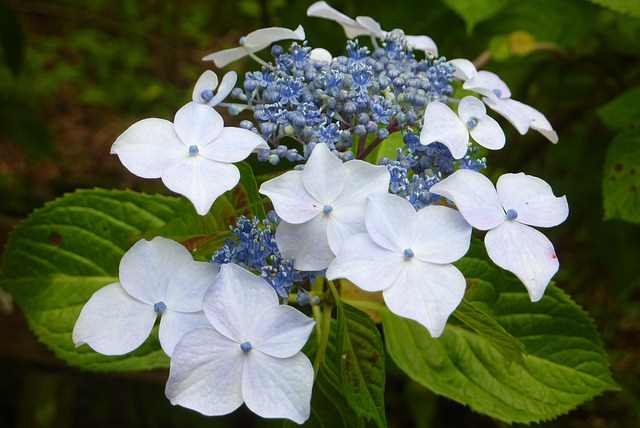
Mountain Hydrangea (Hydrangea serrata)
Mountain hydrangea is one of the smaller varieties of hydrangea with showy light pink or light blue flowers and lush green foliage. The spectacular blossoms change color three or four times a season. This dwarf hydrangea looks like a smaller version of a bigleaf hydrangea with lacecap flowers. Ideal for containers, growing in front of the house, or as a colorful shrub border.
Hydrangea leaves: Small, narrowly ovate leaves with serrated margins.
Hydrangea flowers: Pale pink or pale blue flower clusters that are smaller than other lacecap hydrangea varieties.
Zone: 6 to 9
Sun exposure: Full sun to partial sun.
Height and spread: 2 to 4 ft. (0.6 – 1.2 m) tall and wide.
Mountain Hydrangea ‘Bluebird’ (Hydrangea serrata ‘Bluebird’)
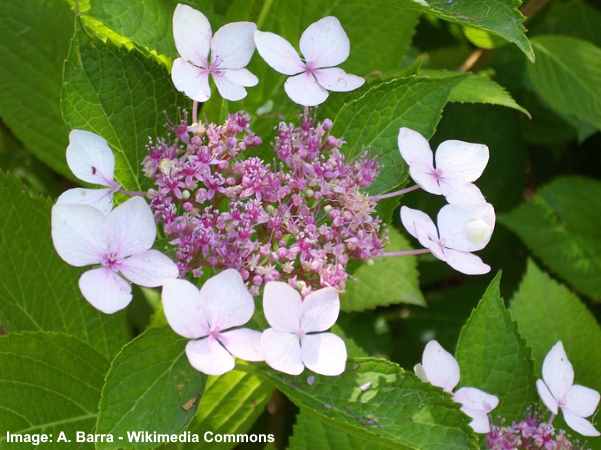
Hydrangea serrata ‘Bluebird’
The compact ‘Bluebird’ hydrangea has beautiful lacecap flowers in blue, pinkish-white, and lilac shades. The delicate, colorful flowers contrast with the dark green leaves. A feature of the hydrangea ‘Bluebird’ is that its green foliage turns into stunning fall colors in shades of red.
The Hydrangea serrata ‘Bluebird’ long blooming season makes this plant a popular choice for container gardens, foundation plantings, and small, informal hedges.
Hydrangea leaves: Mountain hydrangea ‘Bluebird’ leaves are narrowly ovate with finely serrated edges and much smaller than typical hydrangea leaves.
Hydrangea flowers: ‘Bluebird’ mountain hydrangea flowers are pretty lacecap flowers that change color with the soil pH. The dainty flowers can be blue or pink, depending on the soil acidity.
Zone: 6 to 9
Sun exposure: Full sun or part shade.
Height and spread: 3 to 4 ft. (1 – 1.2 m) tall and wide
Oakleaf Hydrangea ‘Sike’s Dwarf’ (Hydrangea quercifolia ‘Sike’s Dwarf’)
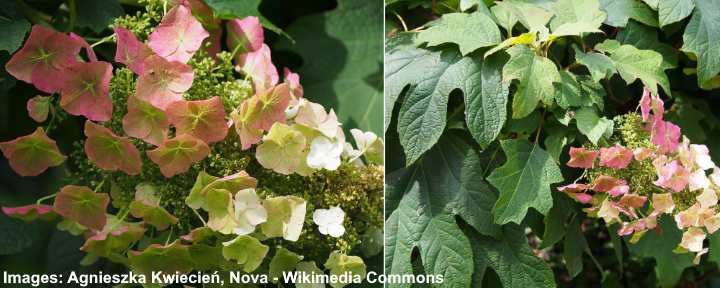
Hydrangea quercifolia ‘Sike’s Dwarf’
‘Sike’s Dwarf’ hydrangea is a compact oakleaf hydrangea cultivar that doesn’t grow taller than 3 ft. (1 m). The dwarf hydrangea features showy cone-like flower clusters that turn from white to pink then light brown. Like all oakleaf hydrangeas, ‘Sike’s Dwarf’ has lobed leaves. Due to its small, compact growth, this hydrangea is suitable for large containers.
Hydrangea leaves: ‘Sike’s Dwarf’ oakleaf hydrangea leaves are oak-like, lobed leaves measuring up to 5” (13 cm) long. The green leaves turn warm shades of bronze and deep red in the fall.
Hydrangea flowers: Hydrangea quercifolia ‘Sike’s Dwarf’ flowers are showy conical spikes of dainty white or pink flowers. In the fall, the flowers turn brown and persist until winter.
Zone: 5 to 9
Sun exposure: Full sun to partial shade.
Height and spread: 2 to 3 ft. (0.6 – 1 m) tall and 3 to 4 ft. (1 – 1.2 m) wide.
Hydrangea paniculata ‘Dharuma’
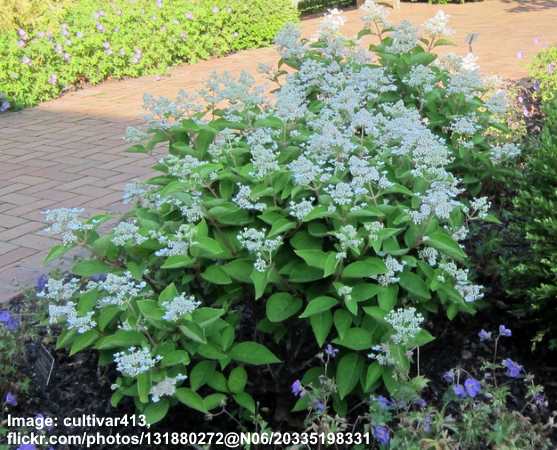
Hydrangea paniculata ‘Dharuma’
‘Dharuma’ hydrangea is a panicle hydrangea dwarf shrub with a slow growth that matures at 5 ft. (1.5 m) tall after ten years. The compact, bushy hydrangea’s outstanding feature is the pointed flowering clusters of pink or white petals and buds. As a small shrub, the hardy hydrangea is perfect for growing in pots or in small gardens where space is limited.
Hydrangea leaves: ‘Dharuma’ hydrangea leaves are narrow ovate leaves with a rounded tip. The deep green foliage turns an attractive yellow in the fall.
Hydrangea flowers: Hydrangea paniculata ‘Dharuma’ flower panicles emerge pinkish-white and turn deep pink throughout the summer.
Zone: 3 to 8
Sun exposure: Full sun to partial shade.
Height and spread: 3 to 5 ft. (1.5 m) tall and 3 ft. (1 m) wide.
Bigleaf Hydrangea ‘Masja’ (Hydrangea macrophylla ‘Masja’)
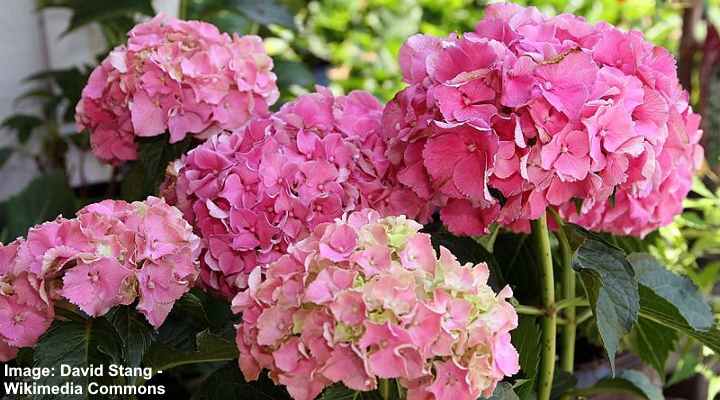
Hydrangea macrophylla ‘Masja’
The ‘Masja’ bigleaf hydrangea cultivar is one of the showiest dwarf hydrangeas for containers and small gardens. The small mophead hydrangea features enormous globular flower heads measuring 6” (15 cm). These pink or red florets contrast with the dark green, glossy, leathery leaves. The dwarf bigleaf hydrangea grows up to 3 ft. (1 m) tall.
Hydrangea leaves: The ‘Masja’ hydrangea leaves are broadly ovate with slight serration on the edges. In the fall, the dark green foliage develops hints of red.
Hydrangea flowers: Mophead hydrangea ‘Masja’ flowers are large domed flower heads made up of 4-petalled red or pink florets.
Zone: 6 to 9
Sun exposure: Partial sun.
Height and spread: 2 to 3 ft. (0.6 – 1 m) tall and wide.
Bigleaf Hydrangea ‘Charm’ (Hydrangea macrophylla ‘Charm’)
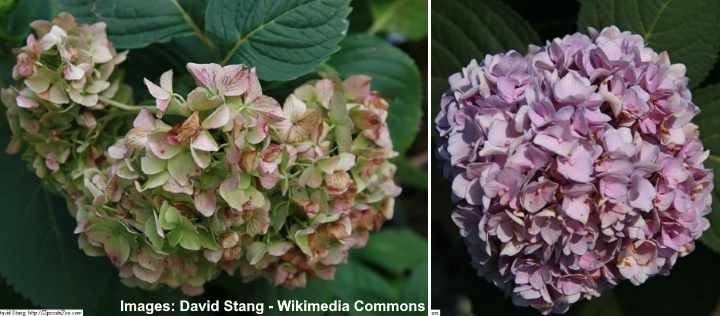
Hydrangea macrophylla ‘Charm’
The ‘Charm’ mophead hydrangea is a dwarf rounded shrub with glossy foliage and large spherical rosy-pink flower heads. Like all Hydrangea macrophylla cultivars, the ‘Charm’ shrub’s flowers change depending on soil acidity—blue in acidic soil and pink in alkaline soil. The attractive round flower heads contrast with the plant’s dark green shiny foliage.
Hydrangea leaves: The dwarf bigleaf hydrangea ‘Charm’ has large, dark green serrated leaves that turn reddish-orange in the fall.
Hydrangea flowers: The mophead ‘Charm’ hydrangea has large dome-like pink or blue flowers measuring up to 6” (15 cm) across.
Zone: 5 to 9
Sun exposure: Partial sun.
Height and spread: 4 to 5 ft. (1.2 – 1.5 m) tall and wide.
Mophead Hydrangea ‘Pia’ (Hydrangea macrophylla ‘Pia’)

Hydrangea macrophylla ‘Pia’
The ‘Pia’ bigleaf hydrangea cultivar is a slow-growing dwarf shrub with dense foliage and compact showy flowers. A feature of the ‘Pia’ mophead hydrangea is that the flowers stay pink irrespective of soil acidity.
Maturing over many years to 3 ft. (1 m) tall, this stunning hydrangea is perfect for containers, window boxes, a small flowering hedge, and small backyards.
Hydrangea leaves: The bigleaf dwarf ‘Pia’ hydrangea has large leathery, coarse leaves.
Hydrangea flowers: The flowers on ‘Pia’ hydrangea cultivars are deep, dusty pink with a domed shape measuring up to 4” (12 cm) wide.
Zone: 5 to 9
Sun exposure: Partial shade.
Height and spread: 2 or 3 ft. (0.6 – 1 m) tall and wide.
Read next: Hydrangea: Planting, Transplanting – Complete Care and Growing Guide
How to Choose the Right Hydrangea for My Garden?
Selecting the right hydrangea depends on factors like your climate, available space, and aesthetic preferences. Research the specific types’ growing conditions and consider the desired bloom color and size.
When Do Hydrangeas Bloom?
The blooming time varies by type. Bigleaf hydrangeas typically bloom in summer, while Panicle hydrangeas bloom in late summer to early fall. Oakleaf hydrangeas bloom in early summer, and Smooth hydrangeas typically bloom in late spring to early summer.
Can I Change the Color of My Hydrangea’s Blooms?
Yes, you can change the color of some hydrangea varieties. Bigleaf hydrangeas can have their bloom color altered based on soil pH: acidic soil produces blue flowers, while alkaline soil results in pink ones. Panicle hydrangeas and Oakleaf hydrangeas maintain their color regardless of soil pH.
How Should I Care for My Hydrangea Shrubs?
Hydrangeas generally require well-drained soil, regular watering, and protection from harsh afternoon sun. Pruning requirements vary by type, so it’s essential to know your specific hydrangea’s pruning needs.
Can I Grow Hydrangeas in Pots or Containers?
Yes, some hydrangea varieties are suitable for container gardening. Choose compact varieties and ensure your pots have good drainage.
How Can I Prevent Diseases and Pests on My Hydrangea Shrubs?
Proper care, including maintaining good air circulation and avoiding overwatering, can help prevent diseases. Common pests include aphids and spider mites, which can be managed with insecticidal soap or neem oil.
Can I Propagate Hydrangea Shrubs From Cuttings?
Yes, many hydrangea varieties can be propagated from softwood cuttings in early summer. It’s a cost-effective way to expand your hydrangea collection.
Are Hydrangea Shrubs Deer-Resistant?
While hydrangeas are not deer-proof, some types, like Panicle hydrangeas, tend to be less appealing to deer due to their tougher leaves and texture.
How Do I Prepare Hydrangeas for Winter?
Mulch around the base of your hydrangea shrubs in late fall to help insulate the roots. Some types may benefit from additional winter protection, such as burlap wrapping or coverin
Related articles:
- Hydrangea: Planting, Transplanting – Complete Care and Growing Guide
- The Best Foundation Shrubs for Front of House
- Small or Dwarf Flowering Shrubs for Your Garden
